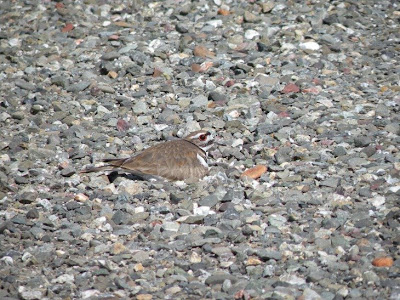Species Spotlight, Vol. 2, Killdeer
 Order: Charadriiformes
Order: CharadriiformesFamily: Charadriidae
Species: Charadrius vociferus
Anyone who has been around Killdeer (especially during the nesting season) can probably guess how they got their specific name. Can you say noisy? The killdeer is one of several species of birds that are very adaptable to human activity. They often nest on gravel roads (such as the bird featured here today). Ordinarily I wouldn't recommend placing a nest of eggs on a roadway, but they seem to know how to pick out the edges where they won't meet rubber doom. Another location where killdeer are often successful nesters is on rooftops and they have been observed keeping their eggs cool in temperatures up to 138 degrees by soaking their belly feathers in water. The young reared on rooftops have been observed surviving falls of up to 50 feet. One thing they haven't adapted to, however, are raingutters, with the young sometimes becoming stranded as they cannot fly.
The killdeer is a type of shorebird known as a plover, which as a group are often identified by their short bill, round head, and plump body. A lot like Grandpa, except his bill is probably longer. A common bird here at Kokopelli WA, the killdeer is very striking with its red eye, orange rump and smooth lines.
The killdeer has several adaptations for nesting on the ground. It exhibits a plumage pattern called disruptive coloration, allowing it to blend in extremely well with gravel roads and other nesting substrates. The double breast band and the lines on its face are two examples of this.
 Additionally, their eggs are spotted and streaked in order to blend in with the surrounding rocks. The killdeer places these eggs in a carefully scraped out nest. On gravel roads, they are often lined with small, white pieces of quartz.
Additionally, their eggs are spotted and streaked in order to blend in with the surrounding rocks. The killdeer places these eggs in a carefully scraped out nest. On gravel roads, they are often lined with small, white pieces of quartz.
 While sitting at the nest, or when protecting young, the parent exhibits a distraction technique to lure predators away from the nest when disturbed. They put on a very believable (and noisy) broken wing distraction dispaly worthy of an award from the Academy.
While sitting at the nest, or when protecting young, the parent exhibits a distraction technique to lure predators away from the nest when disturbed. They put on a very believable (and noisy) broken wing distraction dispaly worthy of an award from the Academy.
After the young hatch, they are on their feet immediately, running around almost as well as their parents, although the do trip and fall from time to time--something which causes my children to giggle hysterically whenever they see it. They can't fly until they get older and their downy feathers are replaced with genuine flight feathers.
References:
Patuxent Bird Identification InfoCenter
Birders Handbook: A Field Guide to the Natural History of North American Birds


So, tell us, were those eggs delicious?
ReplyDelete